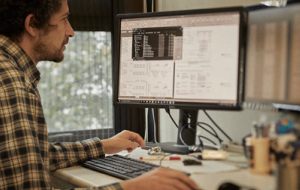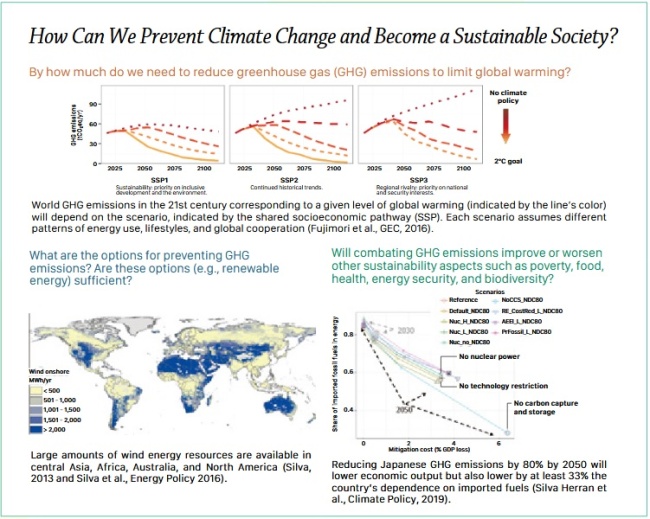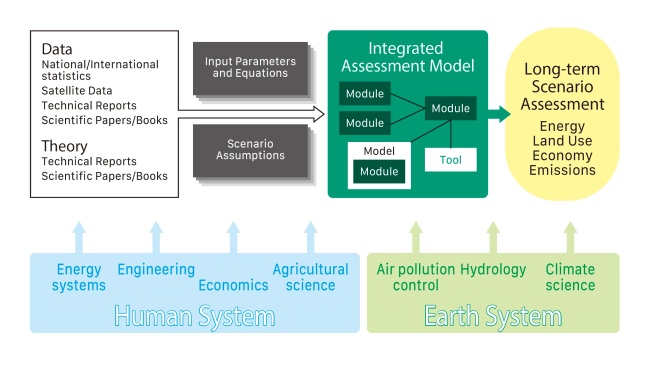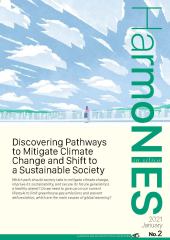HarmoNIES No.2
Integrated Assessment Model
Published on January 2021
Discovering Pathways to Mitigate Climate Change and Shift to a Sustainable Society
Which path should society take to mitigate climate change, improve its sustainability, and secure its future generations a healthy planet? Do we need to give up on our current lifestyle to limit greenhouse gas emissions and prevent deforestation, which are the main causes of global warming?
Which path should society take to mitigate climate change, improve its sustainability, and secure its future generations a healthy planet? Do we need to give up on our current lifestyle to limit greenhouse gas emissions and prevent deforestation, which are the main causes of global warming?
Keywords: climate change, CO2, global warming, integrated assessment model(IAM), low carbon, sustainable society
”NIES researchers developed the Asia-Pacific Integrated Model (AIM), to examine different scenarios to mitigate climate change and their possible consequences.”
…………………………………………………
Fossil Fuels Disrupted the Balance
In the past two centuries, human activities such as burning of fossil fuels and extensive deforestation have disrupted the balance of the natural environ-ment, particularly by increasing the amount of carbon dioxide (CO2) and other greenhouse gasses (GHGs) in the atmosphere, resulting in marked global warming and climate change. The conse-quences can be seen, in part, in the increasing se-verity and number of floods and droughts that are currently being experienced around the world. It is now essential that the world as a whole limits GHG emissions and diligently pursues the realization of a carbon-free society.
Which Pathway Should We Take to Restore the Balance?
Model and Scenarios Shed Light on It
An important question in dealing with climate change and global warming is how society should change to reduce GHG emissions, improve sus-tainability, and leave a healthy planet for future generations. To help answer this difficult question, scientists have developed the integrated assess-ment modeling (IAM) approach, which is a mathe-matical tool that uses computers and national and global datasets to examine how different scenarios may help to mitigate climate change and deter-mine what the possible consequences may be. This scenario-based approach is particularly useful because it allows consideration of many different aspects of society such as population demograph-ics, economic growth, energy uses, technological developments, and consumption of goods and services. At National Institute for Environmental Studies, Japan, scientists have developed the Asia-Pacific Integrated Model (AIM), a large-scale IAM that incorporates economic theory and engineering principles related to energy and technology uses. With the help of these models NIES has conducted research on climate policy since the 1990’s, putting special attention to the Asian region. Asia is key to achieving global climate goals because it includes many developing countries that are undergoing rap-id population growth and development.
Toward a Sustainable and Prosperous Future
The first things needed to reduce GHG emissions are the replacement of fossil fuels (e.g., with renewable resources) and enhancement of the Earth’s capacity to absorb CO2 from the atmosphere (e.g., by expand-ing forests). However, such changes will take time and likely involve huge social disruption. For exam-ple, new technologies and infrastructures are need-ed and alternative consumption and production patterns that are mindful of energy and resource conservation, as well as of environmental pollution, must be established. Furthermore, because each country has their own unique set of priorities, geo-graphic and socioeconomic conditions, and cultural values, measures to tackle climate change must be appropriate for each context. Fortunately, several secondary ways in which combating climate change can bring benefits to society have been identified.
For example, since burning fossil fuels results in the emission of harmful air pollutants, replacing fossil fuels with renewable energy will improve air quality and reduce the incidences of respiratory diseases. Also, expanding the renewable power sector will create more jobs than the losses due to the closure of fossil fuel power plants, and because renewable resources exist virtually everywhere, underdeveloped regions will gain reliable access to electricity. Similarly, reforestation and expansion of forests will restore degraded land, water sources, and biodiversity, and bring new business opportu-nities based on forest products and conservation. Therefore, if the right measures are chosen while taking into consideration the social, economic, and environmental benefits, GHG emissions can be re-duced and natural carbon reservoirs can be restored.
For example, since burning fossil fuels results in the emission of harmful air pollutants, replacing fossil fuels with renewable energy will improve air quality and reduce the incidences of respiratory diseases. Also, expanding the renewable power sector will create more jobs than the losses due to the closure of fossil fuel power plants, and because renewable resources exist virtually everywhere, underdeveloped regions will gain reliable access to electricity. Similarly, reforestation and expansion of forests will restore degraded land, water sources, and biodiversity, and bring new business opportu-nities based on forest products and conservation. Therefore, if the right measures are chosen while taking into consideration the social, economic, and environmental benefits, GHG emissions can be re-duced and natural carbon reservoirs can be restored.
Implementation of the IAM Approach
The world’s nations first agreed to combat climate change with the adoption of the Kyoto Protocol in 1997. Subsequently, adoption of the Paris Agreement in 2015 prompted the development of many models and scenarios to examine whether limiting average global temperature increase to 2°C above pre-indus-trial levels is possible. One such example is the AIM research project led by NIES, which endeavors to develop IAM scenarios in collaboration with Asian researchers to assess the impacts of measures and development pathways that reduce GHG emissions and decarbonize energy systems.
Although results from IAM-based studies can inform policy makers about the choices available to reduce GHG emissions while still ensuring social de-velopment, the results of these studies are not pre-dictions of the future. Unlike natural science which is proved by practical experiments, the assumptions and methodology used in the models are verified by experts after careful consideration and systematic comparisons with the scientific literature and other modeling experiments. What counts most is that the models and scenarios address the concerns of policy makers and assist them in choosing appropriate op-tions based on a scientific and transparent logic
Although results from IAM-based studies can inform policy makers about the choices available to reduce GHG emissions while still ensuring social de-velopment, the results of these studies are not pre-dictions of the future. Unlike natural science which is proved by practical experiments, the assumptions and methodology used in the models are verified by experts after careful consideration and systematic comparisons with the scientific literature and other modeling experiments. What counts most is that the models and scenarios address the concerns of policy makers and assist them in choosing appropriate op-tions based on a scientific and transparent logic
What is Next?
Although climate change, global warming, and the resultant large-scale changes in weather patterns are matters that urgently need addressing, the ultimate goal of IAM research is the realization of a sustain-able society. Scientists from energy, engineering, economics, policy and many other fields, used to approach the climate change issue in isolation. Now, NIES researchers are collaborating to integrate their theories and methods into new models and scenari-os. It is hoped that in the future experts on specific environmental issues will evolve into sustainability experts that integrate local and global perspectives from an extensive and diverse range of research fields.
How Is the IAM and Scenario Research Done?
Researchers survey data and evidence to characterize the elements of the model with numerical data and equations, which include features of the human and the Earth system. Then, a qualitative description of future possibilities for the elements that are of interest for the research, are summarized as scenarios. Scenarios are later described quantitatively, and assessed by means of the IAM, which provides numerical outcomes for major features. The outcomes of research contribute to the climate change science and support policy-making.
What Is the Problem with Carbon?
Carbon, which is the main component of biological com-pounds, is continuously recycled in this planet what is called the carbon cycle. In part of this carbon cycle, carbon dioxide (CO2) in the atmosphere is taken up by plants during pho-tosynthesis; the plants then die or are consumed by animals and the carbon in the plants enters the terrestrial biosphere as organic matter. Thanks to this carbon recycle system CO2 in the atmosphere remained stable, and the Earth itself was sustainable. Burning of fossils fuels produces CO2, which along with other greenhouse gases (GHGs), trap the sun’s energy and causes the Earth’s temperature to rise in a manner similar to how glass acts to increase the temperature inside a greenhouse.
What Is Integrated in the Integrated Assessment Model?
Features of the society, the economy and the environment. These features start with population and economic output (usually measured as gross domestic product), followed by resources (such as energy, materials and land), technologies, emissions (such as GHGs and air pollutants), among others. Since characterizing these features requires knowledge from different fields, integrating them into a common framework is the basic challenge of modelers.
Related Papers
- Diego SILVA HERRAN, Shinichiro FUJIMORI, Mikiko KAINUMA. Implications of Japan’s long term climate mitigation target and the relevance of uncertain nuclear policy. Climate Policy. Vol 19(9), 1117-1131, October 2019. DOI: 10.1080/14693062.2019.1634507.
- Shinichiro FUJIMORI, Tomoko HASEGAWA, Toshihiko MASUI, Kiyoshi TAKAHASHI., Diego SILVA HERRAN, Hancheng DAI, Yasuaki HIJIOKA, Mikiko KAINUMA. SSP3: AIM Implementation of Shared Socioeconomic pathways. Global Environmental Change. Vol 42, 268-283. January 2017. DOI: 10.1016/j.gloenvcha.2016.06.009.
- Diego SILVA HERRAN, Hancheng DAI, Shinichiro FUJIMORI, Toshihiko MASUI. Global assessment of onshore wind power resources considering the distance to urban areas. Energy Policy. Vol 91, 75-86. April 2016. DOI: 10.1016/j.enpol.2015.12.024.
- Diego SILVA Global potential of solar and wind energy considering proximity to urban areas based on GIS tools. 19th AIM International Workshop. Tsukuba, Japan. December 13-14, 2013.
photography: Seiji Narita
Download PDF
Inquiry
International Coordination Office, Planning Division
National Institute for Environmental Studies
16-2 Onogawa, Tsukuba, Ibaraki 305-8506, Japan
e-mail: int-pub{a}nies.go.jp




